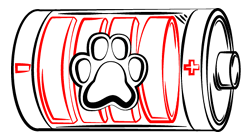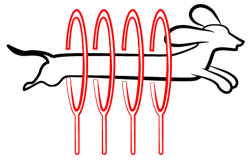
Paws ‘N’ Pups Quickview
Size
| Energy Level
| Trainability
| Paws ‘N’ Pups Rank
|
Characteristics
| Physical Characteristics: Height: 32-38” Weight: 100-180 lbs. Energy Level: High | Colors: The Irish Dane is found in the following colors:
|
Health & Longevity
Average Life Span: 7-10 years
The Irish Dane is a hybrid breed of the Irish Wolfhound and the Great Dane. This mixture of two breeds yields a large pup. When it comes to hybrid breeds, you need to be aware of medical conditions that may affect them by looking at the health of both parent breeds. Some of the medical and health conditions you need to keep an eye out for include cancer, anesthesia sensitivity, bloat, liver problems, heart problems, eye problems, OCD, joint dysplasia, and development issues.
Cancer can present itself at any time in your pup’s life and can appear anywhere in your pup’s body. Cancerous cells can spread quickly, but with the proper screenings at your veterinarian’s office, you and the vet can catch the warning signs early on.
Anesthesia sensitivity is not always a concern, but may be if your pup needs to receive anesthesia for a surgery. This sensitivity can mean that your pup’s body responds differently to the medication than other pups and an overdose may occur.
Bloat is a serious condition that can turn fatal when it is not treated promptly. Bloat occurs when too much air becomes trapped in your pup’s stomach. This air causes the stomach to expand and this expansion can impair the function of other organs in your body.
Liver, heart, and eye problems may appear in your Irish Dane and it is important that you watch out for them. Most conditions will present symptoms, but not all do, so it is vital that you alert your veterinarian if you notice any odd behavior from your pup.
OCD or osteochondritis dissecans is a joint disease that may affect your pup. This disease if common in larger breed dogs and is no stranger to your Irish Dane. The disease can affect the knees, shoulders, or elbows.
In conjunction with OCD, your Irish Dane may develop joint dysplasia. This is another joint condition that causes pain and affects the hip or elbow in your pup.
Lastly, there have been some cases of Irish Dane’s not developing correctly. These issues are not too common, but they occur, so you do need to monitor the growth of your pup.
The Irish Dane has a life expectancy of 7 to 10 years.
Temperament & Train-ability
The Irish Dane is an affectionate dog that will provide you with all of the love you desire from your pup. This breed does well with other animals and is amazing with children, which is why he is an awesome family dog. While your pup will be big, he or she will be gentle with small children, so you will not have anything to worry about.
You will notice that your Irish Dane is playful and likes to enjoy time playing with you. Your pup has some exercise needs and does best in a home that has a large, fenced in yard. You also need to walk your pup twice per day for about 30 minutes each time.
Your Irish Dane is smart, trustworthy, and completely reliable. You will find that this breed makes a wonderful companion for your household.
The Irish Dane will be easy for you to train because he listens well and wants to please you. You will find that you do not have to work as hard at training as you do with other breeds. It is important to make sure you use positive reinforcement and remain consistent.
Grooming
Your Irish Dane does not have a lot of grooming requirements and you will be glad to know that your pup does not shed too much. You should brush your pup’s coat once or twice per week and if your pup has more of the Irish Wolfhound coat, you may need to take him or her to be clipped at the groomers.
You will only need to bathe your pup as needed when he or she becomes dirty or smelly. While a bathe is not needed often, you need to make sure you clean your pup’s ears once per week to avoid infections.
Lastly, you will need to take some time to trim your pup’s nails to prevent them from becoming too long. Nails that are not properly trimmed or kept short will snag and may rip or split. Aim to trim your pup’s nails every 4 to 6 weeks.
Diet
Your Irish Dane will consume anywhere between 4 1/2 cups and 6 cups of food per day. You should choose a kibble that is high in protein and low in calories. The best types of dry dog food are those that contain natural ingredients and do not contain a bunch of chemicals, fillers, and byproducts.
You do not want to feed your pup too much wet food because it does not hold as many nutrients as dry food. You can, however, give your pup some wet food on occasion.
Looking for an Irish Dane?
 Find An Irish Dane Breeder |  Irish Dane Puppies For Sale |  Adopt An Irish Dane |
Cost
An Irish Dane puppy will cost you anywhere between $350 and $1,500. When it comes to the cost of your puppy, you also want to make sure you set aside money to pay for other costs associated with your pup. Some of these additional costs include food supplies for your pup, vaccines, veterinary health checkups, preventative medicine, and other supplies for your Irish Dane. Be sure you also think of what it will cost on an ongoing basis to care for your pup.
Paws ‘N’ Pups Ranking
Paws ‘N’ Pups ranks every breed out of 4 with 1 being easiest to integrate into your life and 4 being the toughest – The lower the ranking the better.
Ranking takes into account a few basic factors including cost, skill level needed, high vs low maintenance and how critical regular training is to success. The Irish Dane is a good companion and a great family dog. You will find that this breed does excellent with children, especially young ones. This breed does not have a lot of grooming needs, but does need to be exercised on a regular basis. This breed ranks a 1.5.
Breeds Similar To Irish Dane
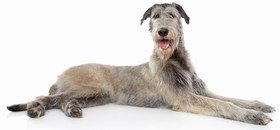 Irish Wolfhound | 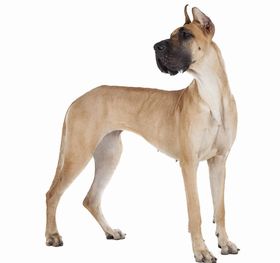 Great Dane |  Bloodhound | 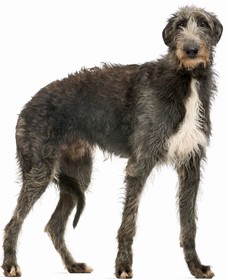 Scottish Deerhound |


